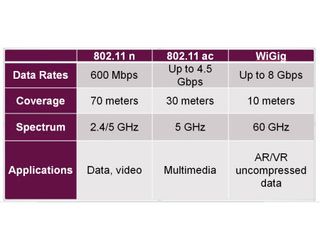Here Comes WiGig: A Boost for ‘WiFi First’

If “WiFi-first” strategies become a central piece of cable operators’ wireless and mobile game plans, a new, more advanced version of the technology may help to lead the way in the years to come.
The innovation, called WiGig or 802.11ad, is the follow-up to 802.11ac, and promises to support up to 8 Gigabits per second over shorter ranges, while also living in the 60-Gigahertz region — sometimes referred to as “millimeter wave” — that will play a role in the coming 5G platform.
Those high-performance capabilities, along with enabling less congestion than 2.4-GHz and 5-GHz WiFi technology, hit on several potential use cases that could serve cable operators and other service providers.
SUPPORTS 4K STREAMING
On the pure capacity side, WiGig will provide more fuel for 4K video streaming, the transferring and synching of massive files. It will also support apps that require extremely low latencies, including virtual reality and 360-degree video. Today’s higher-end VR platforms, such as the Oculus Rift, HTC Vive and PlayStation VR, require users to connect their headsets to PCs or gaming consoles with cables. A WiGig-connected VR platform will aim to do the job wirelessly and push the industry toward standalone headsets.
WiGig appears to be ready for its closeup. The Wi-Fi Alliance, which runs an interoperability certification program, said it has given the green light to a WiGig-equipped Dell laptop, the Latitude E7450/70; Intel’s Tri-Band Wireless client and reference design kits; and reference adapters from Peraso, Qualcomm and Socionext. Many other chipmakers are also in the mix, including Marvell, Broadcom and MediaTek, with TP-Link and Netgear already on board with WiGig access points.
ABI Research forecasts that 180 million WiGig chipsets will ship to the smartphone market in 2017.
Multichannel Newsletter
The smarter way to stay on top of the multichannel video marketplace. Sign up below.
Certification testing is usually viewed as an “inflection point” for most new WiFi technologies, and is expected to be the same for WiGig, Kevin Robinson, vice president of marketing at the Wi-Fi Alliance, said. WiFi now enjoys an installed base of about 8 billion devices, he noted.
MANY USES FOR CABLE
Robinson sees WiGig playing an important role in cable strategies going forward — in and out of the home.
In the home, he said he expects WiGig to come to cable modem gateways that support a growing mix of laptops, tablets, streaming devices and gaming consoles and IoT devices that connect to the home network. The capacity gains from WiGig will also help to eliminate potential bottlenecks because performance will be more in line with DOCSIS 3.1, the new multi-Gigabit data platform for hybrid fiber coax networks.
Akin to strategies being pursued by companies such as Google Fiber, Robinson also expects cable operators to consider using WiGig as a point-to-point “fiber replacement” to connect to homes where extending traditional wirelines is either difficult or just expensive. In metro deployments, WiGig could be used to create bandwidthrich small cells that provide generous throughputs for individual users who are trying to connect, he said.
